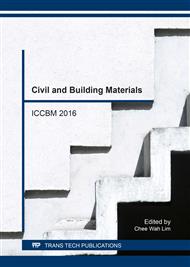[1]
P. Maiz, G. Umlauf, G. Mariani, M. Skejo, B. Cardenas, A. Grochowalski, 2010. PCDD/F, PCB and HCB Emissions from artisanal brick production in developing countries – a case study in México. Organohalogens compounds. Vol 72, 1507-1510.
Google Scholar
[2]
INEGI, 2009. Censos Económicos (2009).
Google Scholar
[3]
B. Cárdenas, (2012).
Google Scholar
[4]
VILLEDA-MUNOZ, G et al. Clay-Brick Firing in a High-Temperature Solar Furnace. Ing. invest. y tecnol. 2011, vol. 12, n. 4, 2016-08-17, pp.395-408.
Google Scholar
[5]
C. Zhang, Pozzolanic Activity of Burned Coal Gangue and Its Effects on Structure of Cement Mortar,. Journal of Wuhan University of Technology - Mater. Sci. Ed., Vol. 21 No. 4, Dec. (2006).
DOI: 10.1007/bf02841227
Google Scholar
[6]
M. C. G. Juenger, and R. Siddique, (2015). Recent advances in understanding the role of supplementary cementitious materials in concrete., Cement and Concrete Research (Available online 13 April 2015), DOI: 10. 1016/j. cemconres. 2015. 03. 018.
DOI: 10.1016/j.cemconres.2015.03.018
Google Scholar
[7]
M. R. Karim, M. F. M. Zain, M. Jamil, and F. C. Lai, (2013).
Google Scholar
[8]
M. F. M. Zain, M. N. Islam, F. Mahmud, and M. Jamil, (2011).
Google Scholar
[9]
R. Cheerarot, J. Tangpagasit, and C. Jaturapitakkul, (2004). Compressive strength of mortars due to pozzolanic reaction of fly ash., American Concrete Institute Journal, Vol. 221, pp.411-426, DOI: 10. 14359/13267.
DOI: 10.14359/13267
Google Scholar
[10]
A. M. Rashad, H. E. H. Seleem, and A. F. Shaheen, (2014).
Google Scholar
[11]
A. Shukla, C. K. Singh, and A. K. Sharma, (2011). Study of the properties of concrete bypartial replacement of ordinary Portland cement by rice husk ash., International Journal of of Earth Sciences and Engineering, Vol. 4, No. 6, pp.965-968.
Google Scholar
[12]
R. J. Detwiler, and P. K. Mehta, (1989). Chemical and physical effects of silica fume on the mechanical behavior of concrete., American Concrete Institute Journal, Vol. 86, No. 6, pp.609-14, DOI: 10. 14359/2281.
Google Scholar
[13]
R. J. Detwiler, and P. K. Mehta, (1989). Chemical and physical effects of silica fume on the mechanical behavior of concrete., American Concrete Institute Journal, Vol. 86, No. 6, pp.609-14, DOI: 10. 14359/2281.
Google Scholar
[14]
A. Goldman, and A. Bentur, (1993). The influence of microfillers on enhancement of concrete strength., Cement and Concrete Research, Vol. 23, No. 4, pp.962-72, DOI: 10. 1016/0008-8846(93)90050-J.
DOI: 10.1016/0008-8846(93)90050-j
Google Scholar


